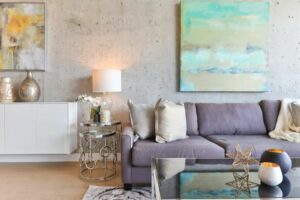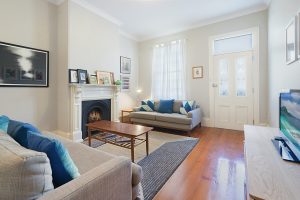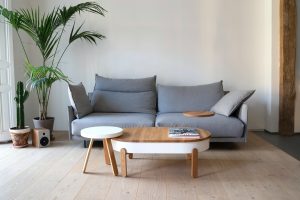Looking for some living room decor tips to inspire you? Good news – you don’t have to duplicate a magazine or online image to create a living room befitting of a magazine spread. Throw caution and “can’t” to the wind, and create a living room that is meaningful and personal to your family. Carefully consider the following questions, and you will be ready to decorate your living room:
1) Examine the room, does it have any outstanding characteristics
2) How will your family be using the living room?
3) Is there a natural focal point in the room?
4) What is your decor style?
5) How are you going to frame the room with the walls and the flooring?
6) How can you make use of the natural light in the room?
7) What prints and patterns will you be using?
8) How can you mix color?
9) How should you place furniture to facilitate the traffic flow?
10) How can you do all of this within your budget?
As you answer these questions using the following expanded suggestions, visualize a living room worthy of a magazine spread, but one that is uniquely yours. Then use these living room decor tips to make your vision a reality.
Does the Living Room Have Any Characteristics That Need to be Deemphasized?

Are you lucky enough to have a perfectly sized and proportioned living room, or does it have features that you need to accommodate? Some common issues are small, large, and long and narrow rooms.
You can create the illusion of a larger room by using carefully placed mirrors, lighter colors, furniture that is less massive, lighter-toned wood, and drawing the eye up with items such as floor-to-ceiling drapes. Painting the ceiling a few shades lighter than the walls also adds height. Do not crowd too much furniture, accessories, or visual highlights into a small room.
Larger living rooms can be made to feel less massive by creating multiple furniture groupings and using area rugs. Make sure only one area is dominant while the other areas serve to draw your eye around the room without being stopped by a heavily competing area. High ceilings can seem lower if you paint the lower part of the walls a darker color and the upper part a lighter color. Larger, heavier furniture in darker woods also fills space.
For a long narrow room, start by creating a path, preferably a straight path, to one side of the room, allowing furniture to be arranged on the other side into two groups occupying two-thirds and one-third of the room. Arrange the main conversation setting around a round coffee table or hassock. Create a table and chair area, reading area, or a desk area in the other third of the room. Just as you do for small rooms, draw the eye up with items such as floor-to-ceiling drapes, and use light colors and lightweight furniture. Don’t clutter the room with too many items or accessories.
What Is the Intended Use for Your Living Room?
Will your living room be a place where your family will gather, or will it just be used for entertaining while your family favors another room? If the family is going to use it as a gathering and activity center, then you need to make a list of the items that need to be included in the room, such as a television and a games area, and find room for them. If it is just going to be used for guests, then you can concentrate on aesthetics and not on the utilitarian aspects.
What will the Focal Point be in Your Living Room?

Some rooms have natural focal points. Do you want to emphasize any natural focal points or create your own? If you want to emphasize a natural focal point, carefully build items around it that support it without overpowering it. For a window, create a window treatment that helps draw your eye there.
Fireplaces require adding items on the mantel and on both sides of it that support but don’t overpower it. Built-in bookcases – add displays to the bookcase that create interest without being cluttered. Place furniture so that it faces your focal point or set a larger piece of furniture, such as a sofa, in front of the focal point to help draw your eye to it.
To deemphasize a focal point, use neutral colors and create a monotone area, such as deemphasizing a window using drapes that are the same color as the wall. Monotone doesn’t mean boring. It means that the area blends in and complements the room without drawing attention.
To create your own focal point, use an item such as wall art or a piece of furniture that is special to your family as your center of interest. Support the attention that you are trying to draw to it by doing things such as creating an accent wall behind it, arranging the furniture to face it, or sitting furniture in front of it. This will make your room magazine-layout-ready and yet personalize it.
What is Your Style?
Do you favor traditional, modern, minimalist, or rustic decor? Defining your style helps you set boundaries that create a unified look. However, you can blend in items that are outside the style you are featuring to create interest and personalize your living room, such as a few steampunk items in a traditional room.
Living Room Decor Tip #1: Use Your Walls and Flooring to Frame Your Room

If you think of your room as a piece of artwork, then your walls and flooring are the frames. Frames aren’t always plain. They can have accents without competing with the artwork that they are framing. You can do the same with your walls and flooring.
As already mentioned, you can paint three of your walls one color and use the fourth wall to create a different color accent wall. You can also wallpaper one wall, paint it with a design using multiple colors, or give it any other treatment to make it the focal point of your room.
The same idea can be applied to your flooring. Many flooring companies have designs that range from parquet to medallions and other true focal point designs. If you want the room to look bigger, maybe you want to extend your flooring between rooms to create a more cohesive look. So browse and see what is available and consider these options.
Living Room Decor Tip #2: Make Use of Natural Lighting
Light colors make a room brighter and shades of white help reflect the natural light while giving a warm feel. Use satin paints instead of matte paints to also reflect natural light. Mirrors, glass, metals, and the shiny wood surfaces from furniture and wood floors also help reflect the natural light.
Try to arrange the furniture in the room so that the natural light is located in the areas that need it the most, such as reading areas. In addition, custom window treatments can help you enhance the overall aesthetic appeal of your room while leveraging natural sunlight to brighten your room.
Living Room Decor Tip #3: Mix Wood Tones

Don’t be afraid to use and mix. These days, it’s not uncommon to mix various shades of wood in one room. This more modern approach allows you to blend rustic style wood with various stains and grains, creating a look that is diverse.
You can achieve this by purchasing wood flooring that compliments your flooring without being exactly the same. One way to still make the look cohesive sit to keep similar undertones of the wood similar.
Living Room Decor Tip #4: Balance Color and Texture
Gone are the days where you need to match everything to your hardwood floors. Now, it’s easier to see hardwood flooring as a base or neutral, allowing you to build the room from there. Don’t feel like you need to pick wall colors or art that perfectly match your floors. Bring in bright colors and allow yourself to get creative.
Also consider adding texture in your accent pieces to balance out the hardwood floors. This can be done with plush rugs, airy window treatments and even softer sofas.
Living Room Decor Tip #5: Place Your Furniture to Create a Smooth Traffic Flow

Now you are ready to decide where to place your furniture. As we have already discussed, furniture placement is affected by the size and shape of the room, your focal point, and the natural lighting. You should also consider the traffic pattern. Consider how people will move between doorways in the room, and don’t block that flow. Then, try to create 3-foot, easy-to-maneuver paths between the furniture. Finally, consider the overall look of the room and make adjustments.
Living Room Decor Tip #6: Learn to Decorate on a Budget
Decorating or redecorating a room can be expensive, but there are ways to cut the cost. First, do a little at a time. Of course, you want to have the new look immediately, but sometimes it is necessary to do the project in small steps. Look for found items or items that you can repurpose and use them. If you see someone throwing out something that you can use, ask them for it. Look for items in other rooms or items that have been stored away in your home and use them.
Shop for items on Craigslist, at second-hand stores, and check out garage sales. Let your family and friends know what is on your wish list so that they might be able to get it for a gift-giving occasion. Finally, see how many of your friends might be interested in participating in a home decor exchange. All of you can bring items or pictures of items that you no longer want and select items that others have contributed that fit your new look.
Conclusion
It might help you to use a spiral notebook to record your ideas and organize your plan as you work through the various aspects of decorating your living room. As you read through your notes, you will probably find additional ideas and inspiration. This will also help you edit ideas and control your budget. In the end, you will have a room that will look as editorial as any living room seen in a magazine, but it will be your own unique and personalized living room.